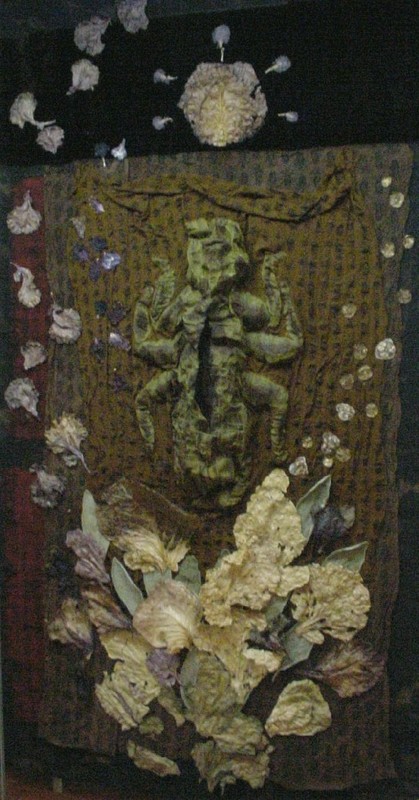Joann Engelhart
Independent Artist and M. F. A. Candidate, Department of Visual Art, University of Wisconsin-Milwaukee
Sanctus Insectorum.
Cotton, wool, rayon velvet, silk, linen, paper,
dye, pigment, organic material.
The basis for my work is the garden of my childhood, which consisted of six acres of vegetables and cornfields, flanked by a creek on one side and deep woods on the other. This was my world of exploration and discovery, examining nature with a spirit of adventure and fun. But it was also a place of terror and hidden dangers: animals in the dark woods, crawling insects and snakes, huge spiders and unknown leggy things hidden by coverings of webs and leaves.
Recently, I planted a 900-square-foot garden to rekindle the memories of childhood. My garden plot was part of a community garden, set amidst sprawling fields teeming with wildlife and insects. This garden was destroyed by insects--not at all what I had expected. In researching information about bugs, especially mites, I came to realize the importance of insects: they form the basis of an ecosystem that supports human existence. Mites, ants, beetles, maggots, and worms recycle the detritus of vegetable and animal life, thus supplying nutrients for plant growth that supports animal development.
I wanted to present the importance of the insect to the viewer, but needed imagery and a format. Books from Special Collections at the Golda Meir Library, University of Wisconsin- Milwaukee, contained beautiful, hand-drawn images of lice and other specimens. In particular, after viewing louse specimens in one book, I decided to create an insect reliquary, thus indicating the specialness of the insect. The large, splayed louse suggests a crucified corpus, and other images convey mystery and religious allusions. The use of text implies a human connection, and overall there is a sense of the cycle of life and death.

